|
 |
|
 |
|
 |
 |
| |
16:9 in English: The Nursemaid’s Buckle
By MARK LE FANU
Anyone who has visited the Film Museum in Berlin and seen the surprisingly red uniform worn by Emil Jannings in Der letzte Mann (1924) will know that the physical object and its cinematic counterpart are essentially different – of an entirely different order. Objects in cinema have a life of their own that extends beyond their on-screen appearance but it is the life of objects on the screen that have the most enduring appeal.
A new film museum has opened in London in the cavernous neo-baroque building that used to house the old County Council on the riverside, a stone’s throw from the revolving Eye, London’s most popular tourist attraction. Visiting it on a recent trip to England, I became touched by a familiar melancholy, for years ago I had been involved in the setting up of a similar enterprise. The Museum of the Moving Image, as it was called, ran for a few years from the late 1980s before closing down, victim of government cuts made to its parent body, the British Film Institute. I don’t know whether any of the “treasures” we had managed to corral together have ended up in the new collection: I can’t say I spotted any. But the kind of object that tends to turn up in such places may easily be imagined. So, for example, in this new collection we have: the cloak worn by Harry Potter in one of the earlier episodes of the famous money-making franchise; the monkey-costume (or one of them, anyway) that graces the opening scenes of 2001: A Space Odyssey; a pair of miniature dinosaurs crafted by Ray Harryhausen from some long-forgotten pre-Kubrickian science fiction movie of the fifties; and so on – downwards.
The thinness on offer is partly a matter of starting so late. The most resonant icons have long since all been snapped up. It is not every film museum, after all, that can boast possession of the original cane and bowler hat of Charlie Chaplin (fig. 2). Even in this case one might want to ask, however: what would “original” mean in such matters? Presumably along the length of Chaplin’s career there were many canes, and many “bowlers”. The studio prop department, in its humble way, would have been expected to have a supply of such items. Separated from their animated contexts on the two-dimensional screen, these three-dimensional objects remain – for me, at least - obstinately “fusty”, stubbornly withholding any treasure-like status their new owners would wish to confer on them. The original? Or a mere simulacrum? For all the glamour that is involved, it seems not to make very much difference. The whole notion of prop has at bottom something piecemeal, even tawdry about it. While the word itself is a shortening of “property” (so that the props room in a theatre is merely a slang way of referring to the property department), it carries with it an overtone of something – or someone – “propped up”, supported. |
|
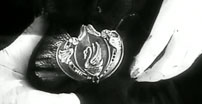
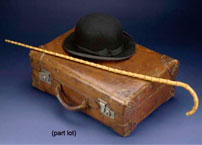
Fig. 2. One of several ‘original’ Chaplin bowler hat and cane/The Henley Private Museum, Auckland, New Zealand. |
|
| |
Functions of props
At its most basic level of functionality, the poor bare prop compensates for (or overrides) the actor’s shortage of talent – the mask or costume, rather than the performance itself, providing the essential evidence that we the audience are indeed in the realm of the theatre. Props most come into their own, therefore, in the context of comedy, which derives so much of its strength from repetition and stereotype. Groucho’s moustache, M. Hulot’s pipe and raincoat, Harold Lloyd’s glasses (fig. 3), Buster’s boater: reassuring metonymies, identifications of “the brand in question”, whose very familiarity already puts us in the requisite good humour. Yes, the theatre has something gimcrack about it - it wouldn’t be theatre if it didn’t.
So the prop is both humble and necessary. Not to get the point of it is not to get the point of theatre, which relies, for its effect, on our seeing through the illusion at the same time as we are sustained by and (as it were) enthralled to it. Costume is indeed magic –among the deepest magic there is. How many times, in theatrical memoirs, has one come across passages where the actor or actress explains to us that it is only when he or she has for the first time slipped into clothes specially put out for them that the role in question “gels” and comes together in its unity and authority. Rather rare and recondite skills are involved here. The designer of décor, the supplier of furnishings, the cutter of cloth, the dressmaker, the accessorist, the prop scout are not public figures in the way that the director and writer are; but without them the spectacle in question (and indeed spectacle itself) would be unthinkable. They are the professional equivalents of those special friends we may be lucky enough to have at different stages of our lives whose taste and generosity permit them to intuit, quasi-infallibly, the right gift for the right occasion – modestly wrapped, delivered with a smile, and inexpensive: perhaps indeed the work of their own hands! Artistic talent put to good use is itself a kind of generosity, and though we pay for the theatre, the best performances retain always something of the aura of a “treat”. |
|
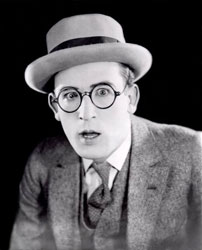
Fig. 3. Harold Lloyd and his trademark glasses. |
|
| |
Intuitive fetishism
Perhaps because of the power of the close-up, objects in the cinema, as opposed to the theatre, have a startling particularity – a “this-ness” – about them. The great filmmakers (and some of the not-so-great too) are in tune with an intuitive fetishism. In certain cases – one thinks of Lang, or Bunuel, or Hitchcock, or Kubrick – it would not be inaccurate actually to label these artists fetishists (fig. 4). Called upon a hundred times a day to make choices about the smallest item of apparel – should our actor wear brown shoes or black? “Brown, of course.” In that case, what shade of brown? – his or her very survival depends on developing a ruthless sixth sense in such matters.
The filmmaker’s perfectionism, certainly, has something obsessive about it, and one is not surprised to hear accusations directed against some of the most famous of them that their actors and props seem interchangeable – the human personality of the actor in question just one more aesthetic “value” (along with sound, colour, landscape and décor) in the total overall composition. The morality on display in such cases is clearly a bit dubious, and perhaps we shouldn’t pursue it too closely; at any rate, it makes up a good part of the legendary “monstrosity” of directors just mentioned such as Hitchcock and Kubrick (and, for all I know, such modern masters of the mechanical as James Cameron). The “fetish” component can be found rather nakedly in the work of directors like Bunuel and Walérian Borowczyk, where the secret objects in question (jeweled reticules, women’s furs and undergarments, experimental leather footwear) have a patently erotic appeal about them.
But one may wonder whether this fixation on precise objects is not, anyway, part of cinema's deepest metaphysics. I think of Orson Welles in this connection, and a film like Citizen Kane. Welles came from the theatre of course: he was one of the finest American stage directors of the 20th century; but the move over to cinema resulted in a poetics that is different in kind from that of stage magic – a different phenomenology is operative. Citizen Kane is many things; its excellences may be variously characterized. But the attention the script pays to objects – the snowy globe (fig. 5), the legendary sledge, the stove from the log cabin, the priceless riches of “Xanadu” piled up forlornly in the final scene in packing cases – constitutes a central part of the film’s appeal, and indeed of its enduring mystery. There is something in this film about the way that cinema speaks to us, that it would be impossible to replicate on stage.
Eisensteinian props
Eisenstein’s films have always seemed to me exemplary in this respect: he too belongs to the tribe of collectors. Along with its celebrated library, his apartment in Moscow was stacked with sculptures and curios – a significant personal hoard which, in an epoch disdainful of private property, may have made him suspicious to the authorities. Many of these things came back from his travels. The decorated skulls and mortuary masks which give such an extraordinary visual resonance to the surviving fragments of his lost masterpiece Que Viva Mexico! testify, at any event, to a taste for objects that were rare, exotic and satirically imbued with the flavor of death: in these matters as in so many others Eisenstein was the most sophisticated of connoisseurs. |
|
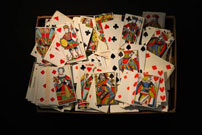
Fig. 4. The University of Arts London house The Stanley Kubrick Archive which includes these playing cards from Barry Lyndon (1974).
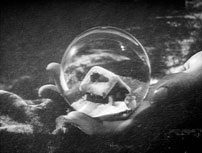
Fig. 5. The snowy globe at the beginning of Citizen Kane (Orson Welles, 1941). |
|
| |
In 1941, following the German invasion of the Soviet Union, the Mosfilm Studios were transferred 3000 kilometers across the Urals to the desolate wastes of Central Asia. The reconstruction here in Alma Ata (modern Almaty) – out of absolutely nothing, so to speak – of 16th century Russia which Eisenstein effected in order to furnish his last, greatest epic Ivan the Terrible, has something unimaginable about it. From where, in those times of scarcity, did he succeed in conjuring up the materials – the fabric, jewels, weaponry, costumes – that would allow this great canvas to come to life? (fig. 6) Jay Leyda’s book Eisenstein at Work (1982) makes it clear by reference to the film’s surviving storyboards how much of the design of the film, down to the smallest details, owes to Eisenstein’s personal artistic draftsmanship; not only, architecturally, the vast imagined space of the cathedral interiors, but also the swarming multiplicity of icons and murals decorating them. One of the great scenes of the film is the youthful Ivan’s coronation in Part I: here are film images that stick with you. As Cherkassov, playing Ivan, stands there proud and handsome in his robes, twin servitors on either side pour over his head a stream of golden coins that splash down like water over his body and slippers: representation of God’s (and through God, the Tsar’s) generosity towards the Russian people (fig. 7). Here, then, is one enduring aspect of the “magic” of cinema: its lavishness. The scene is dependent for its power on the beauty and particularity of its furnishings, which are brought to our gaze in close-up as well as in long shot.
Eisenstein’s earlier films are also of course “object-fixated”: one thinks of the montage of exotic deities gracing early scenes in October (fat reclining Buddhas, grinning Polynesian idols, saccharine madonnas: bunched together to show – as Eisenstein thought then – the false magic of religion); or, from the same movie, the collection of Tsarist bric-à-brac – statuettes of Napoleon (demonstrating Kerensky’s megalomania), the mechanical peacock (his pride and fatuity), the segmented liqueur decanters, the Fabergé eggs (extravagance, decadence): these objects are marked, semiologically, as false and repulsive in terms of the film’s governing ideology; but at the same time we can sense Eisenstein’s private delight in them (fig. 8-10).
Even this early (1927/28) it is possible to believe that Eisenstein was not a simple “believer” in the cause. Or maybe, in retrospect, it is truer to say that Eisenstein the connoisseur aesthete and Eisenstein the party propagandist were engaged, from day one, in underground battle with each other. Who knows what this great man believed in, in the depths of his being? His films are ambivalent because (and one can say this especially in the context of his silent movies) images themselves – silent images – are ambivalent. They can always be read either way. That seated statue of Alexander III, for example, that we first see toppling from its pedestal and then, as the film-stock is put into reverse, reconstituting itself: whose power is being interrogated here? The imposter Kerensky’s, of course; but why stop there? Maybe even as early as this it was Lenin’s and Stalin’s power that was being questioned: all power, in other words, wherever it comes from, may be seen to contain within it the seeds of future autocracy.
One shouldn’t be either perverse or unhistorical about these matters: let us agree that Eisenstein sincerely hated tyranny. If we ignore the moral outrage expressed in October, or in a film like The Battleship Potemkin, we ignore the movie; their shared ideology is revolutionary communism. Yet Eisenstein, as we have said, was “also” an aesthete, and the message of these films is far from straightforwardly socialist. Take Potemkin for example. The movie refers back to a time (1905) when nascent proletarian consciousness, represented by the mutineers, was in alliance with “progressive” sections of the middle classes. This is the significance of the Odessa Steps sequence, for the citizens of the township, gathered at this vantage point to wave their support to the sailors, are recognizably bourgeois: we can see this (how else could we see it?) by means of their costumes, particularly in the case of the women, with their flowing dresses, elegant veils, and parasols.
Three women, famously, are singled out and come into focus as the Cossacks begin their fateful descent of the steps: the first, with thick black hair and rough-drawn features, is the mother of the white shirted boy who shortly will be killed and trampled upon (she is killed herself as, with the child in her arms, she re-climbs the steps to plead with the soldiers). The second woman, identified by her pinz-nez (a pinz-nez that will be shattered by rifle shot and sabre cut by the time the Cossacks have done with her), seems to be in charge of a little group of stragglers who – relying on her - huddle behind one of the steps’ protective piers. Finally there is the majestic woman dressed in black, sometimes referred to as “the nursemaid” in traditional accounts of the movie, though possibly (and maybe indeed even probably) the mother of the baby in the pram she is guarding. |
|

Fig. 6. Crown, sceptre and orb from the coronation scene in Ivan the Terrible, part 1 (1945).
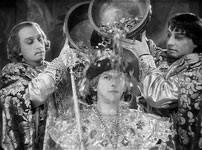
Fig. 7. Ivan the Terrible, part 1 (1945).
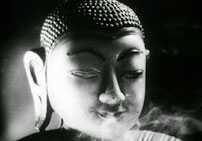
Fig. 8. October (1928).
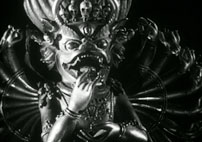
Fig. 9. October (1928).
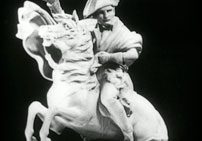
Fig. 10. A statuette of Napoleon from October (1928). |
|
| |
The filmic representation of this latter “martyr to the revolution” has always particularly intrigued me, for, in the midst of the massacre, the attention Eisenstein devotes to her death throes is curiously and strikingly erotic. The swoon of death, repeated four times (in close-ups that surely count as being among the greatest in cinema) is also a swoon of ecstasy. She has been shot in the stomach and, before releasing her grip on the handle of the baby carriage that will consequently skittle down the steps (bearing its human cargo to its doom), the camera comes back to an arrestingly unexplained detail: the buckle of her belt, exhibiting a cameo with an engraving of a swan on it (fig. 11-12).
One might ask whether any explanation is needed. The close-ups of the buckle in question are there to signify where the woman has been shot, and the detail of the white-gloved hands grasping the belt and smearing it with blood, while striking enough in itself, is perfectly compatible with the extraordinary vivid realism which marks the entire sequence in general. Yet perhaps it is because animals and birds lend themselves so readily to heraldic meaning that one finds in this image of the swan such a surplus of symbolism - lingering there like some detail in a dream that demands to be interpreted. Curiously, none of the standard commentaries I know of see fit to pause on this detail. And the fact that such commentary doesn’t exist (nowhere, anyway, that I can find it) may be especially what makes me want to pause over it here, at the end of this essay. Did Eisenstein “mean” anything by specifying this particular item of apparel? Alas, he can no longer be questioned. But Naum Kleiman, curator of the Eisenstein museum in Moscow and the greatest living authority on the director is still alive, and one of these days, when I next meet him, I will ask him. If he knows anything about the matter, I am sure he will tell me. We are not, I think, talking about Rosebud here, or the meaning of a man’s life. More like the reporter Thomson’s verdict at the end of Welles’s movie: “Just a piece in a jigsaw puzzle…a missing piece”. It would be intriguing to be able to name it, and place it in the overall mosaic. |
|
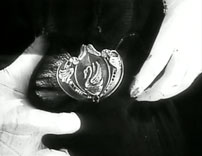
Fig. 11. The first close-up of the ‘nursemaid’s buckle’ in The Battleship Potemkin (1925).
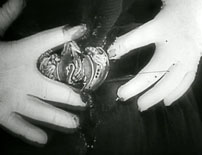
Fig. 12. The second close-up of the buckle. |
|
 |
 |
 |
 |
 |
|
 |
 |
 |
| |
Facts
Literature
Leyda, Jay; Voynow, Zina. Eisenstein at Work (New York: Pantheon Books, 1982)
For more on the ’memorabilia industry’ that exists as regards props, visit www.originalprop.com |
|
|
|
|
 |
 |
 |
 |
16:9 - februar 2010 - 8. årgang - nummer 35
Udgives med støtte fra Det Danske Filminstitut samt Kulturministeriets bevilling til almenkulturelle tidsskrifter.
ISSN: 1603-5194. Copyright © 2002-10. Alle rettigheder reserveret. |
11 |
|
|
 |
 |
|
|